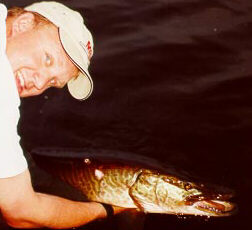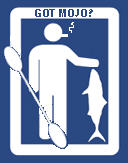|
|

Posts: 714
Location: Rhinelander, WI | I have a question regarding turnover.
Do lakes that don’t develop a thermo-cline turnover in the fall? I think they do.
There has been lots written about this topic, and usually there are statements that say shallow lakes, that do not stratify, don’t turnover. I am wondering if this is actually correct.
If I remember my water chemistry correctly water is most dense around 39 degrees. After that it starts becoming lighter again. So as temp decreases it becomes heavier until it hits that magic number and starts getting lighter until it freezes.
If that is the case even shallow lakes will see some type of turnover as the surface temps drop below the bottom temps.
I understand this wont be as dramatic as a deep lake with stratification, but it still has to have and effect on the lake and fish that swim in it.
Any ideas on what these shallow water flips do and how to overcome them if you are forced to fish a lake going through this process.
Thanks
Nail A Pig!
Mike
| |
| | |

Posts: 1764
Location: Ogden, Ut | Mike,
I think it would depend on 1) how stable the summer 'temperature gradient' (not true thermocline) is and 2) the depth to which wind will affect it's stability. One good windy day can often break these situations up long before changing fall temperatures will. I too think there's a case to be made for shallower lakes setting up a stratification event, but I really have no idea how it would affect the fish. The degree of change is obviously less than that of a true 'turnover' but it would seem reasonable that the overall change in temperature occurring over such a short period of time would have some effect. It would probably be somewhat less dramatic that the fish would likely adapt to the change a bit quicker. Depending on nutrient availability and the species composition of the phytoplankton, a bloom of some sort may also occur. This may change the availability of dissolved oxygen concentration over each 24 hour period. Sometimes I wish I'd have taken more water chemistry courses, but at the time, it seemed like enough was enough...
Sorno | |
| | |

Posts: 32944
Location: Rhinelander, Wisconsin | Sorno,
Wouldn't the lake hit a temperature which is the same top to bottom? Even if the lake didn't thermocline, that event, the equal temp through the water column, is what always was to me the signal the fall 'cooling water' period had arrived. The difficulty for us anglers is when the temps are nearly the same throughout the water column and in the event on a lake where maximum depth is say 23' and there has been no stratification to the point of thremocline, as the water cools the fish seem to roam wherever the food roams including the panfish which tend to cluster in the basins that time of year, and get a little harder to track for a time. As the water continues to cool and reaches the low 50's down to high 40's, it seems to me the algae clears up and the fish seem to go back to a form of fall predictability. Am I off the edge on this one? | |
| | |

Posts: 1764
Location: Ogden, Ut | I think it does hit a temp that is the same top to bottom - it just sometimes happens for different reasons than the classic fall turnover. It may 'stratify' to a certain degree with a week of calm, hot weather in July and a big wind may break it all up or nearly so. I just don't think you have to wait until fall for it to mix thoroughly in all cases. Even if there is no classic thermocline, water density changes with temperature. In the summer there will almost always be cooler water as you submerge. It takes quite a bit of mixing power to break it up, even if the classic 'thermocline' doesn't form. Water is most dense at 4C and progressively lighter (and therefore more buoyant) moving away from that temperature, both cooler and warmer. Changing temps will mix it all by itself, but sometimes, you don't have to wait.
S. | |
| | |

Posts: 2754
Location: Mauston, Wisconsin | From what I've read regarding relatively shallow large bodies of water like St. Clair, Mille Lacs, and Winnebago, etc. these shallow lakes don't really develop a thermocline- rather the primary impact on thermal stratification in these waters is wind. Any significant wind pretty well keeps them thermally mixed, i.e., prevents a thermocline from developing.....
If turnover is a potential issue-fish relatively shallow lakes or rivers (shhhhhhhhh-did I say rivers?).
Have fun!
Al | |
| | |

Posts: 32944
Location: Rhinelander, Wisconsin | So let's take a small Wisconsin lake as an example, in this case 500 acre plus Lake George. There is an outlet to the Pelican River, but very little water flow this time of the year. Max average depth in the basin is low 20' range. Rocks, shallow weeds, and dark water are the conditions. I have never seen a classic thremocline set up as perch and walleyes live in the deepest portions all year very nicely, but I have seen top temps considerably warmer than that of the water 10' deeper, unless as you mention there is a huge wind. The lake is pretty well protected, so winds have to really whip in the 30 MPH range to even get a 2' chop.
A few weeks ago, the surface temps were 72 degrees. Now they are in the upper 50's, and during that change, or cooldown, the lake bloomed with algae. It clears up when the water hits low 50's, and is REALLY clear when it gets into the upper 40's. The weeds are dying off, too. There are dozens of lakes in the area that fit this description. Not really a turnover, but a cooldown, I guess. This is what many folks think is the turnover, I've heard people talking about it. This ISN'T really a turnover though, because the lake was never theromclined anyway, correct? | |
| | |

Posts: 1764
Location: Ogden, Ut | I would consider it a turnover. A classic thermocline doesn't necessarily have to set up in order for a turnover to occur (to break it up). Even though there is no classic thermocline (a band of water where temperature changes the quickest), there may, and almost always is a general decreasing temperature gradient as you get deeper. Once the water at the surface begins to cool, it gets heavier and begins to sink, creating a turnover situation.
I'll see if I can illustrate this (this is from memory, so the numbers may be way off - it is for illustrative porposes only)
I can't seem to get things to line up in columns, first column of numbers is depth, second is temp of 'classic' lake (at that depth), third is temp (again, at depth) of lake w/o true thermocline.
Classic thermocline Shallow lake temperature gradient (often wind mixed)
depth(ft) temp temp
surface 72 72
2 69 71
4 65 67
6 63 64
8 60 63
10 58 61
12 53 59
14 50 57
16 48 55
18 47 54
20 44 53
22 43 53
24 42
26 41
28 41
30 40
32 40
. .
. .
. .
The thermocline would be in the area of 12 to 18 ft depth strata - the temp changes rather dramatically for relatively little change in depth. In the second example, the lake does not exhibit a true thermocline, for whatever reason, but does still have a temperature gradient. Both systems are subject to a turnover of sorts - the first one is more dramatic, as there is more cooler water to mix when it does finally occur. But the second will turn and mix, the degree of change is tempered somewhat by the lack of volume of the very cold water below a thermocline. This ended up looking terrible, but I hope it explains it somewhat.
Sorno
| |
| | |

Posts: 714
Location: Rhinelander, WI | Steve’s example is exactly what got me thinking about this, I have seen this phenomenon on a number of relatively small shallow lakes. And I think it is a turnover, though admittedly not as bad as a thermocline flip. I have seen this on the Rhinelander Flowage, (backwater regions), Hancock, Pelican (Musky Bay, right now) and numerous other lakes.
I think the key is the size of the shallow lake, St. Clair, Mille Lacs, and Winnebago, etc are probably to big to see this kind of turnover because the wind is always mixing them. I don’t think we get enough wind up here to get big enough waves on these small Wisconsin lakes to mix them between 10 and 20 feet down.
When that surface temp drops below that bottom temp what ever is suspended near the bottom comes to the top with that water and we see that short lived bloom. I typically have struggled when the shallow lakes have been in this condition. Any suggestion on how to find fish under these conditions?
On the Deep Clear lakes, going to the shallow weeds has produced for me. Maybe that is what I should concentrate on with these darker shallower lakes and shallow weeds are relative. On some of the deep clear lakes I fish shallow weeds are 8 to 10 feet, maybe I need to look for green weeds in the 2 to 4 foot depth range on my favorite shallow lakes during this mini turnover.
Thanks guys for a great discussion!
Nail A Pig!
Mike
| |
| | |

Posts: 32944
Location: Rhinelander, Wisconsin | Mike,
I can speak to Musky Bay, I finally figured that one out a few years back. I do really well concentrating on the heavy cover in about 3 to 4' of water during the bloom and cool down. Spinnerbaits and bucktails seem to be the ticket, with a shallow glider a close third. I'm a good casting distance up inside the stuff, concentrating on the NW to SE weedline running across the mouth, and the NE to SW weedline running up into the bay on the south side, the bay side of the 'trench' there, not shoreline.
The smaller dark water lakes make me crazy during this pattern. The only fish I usually find are shallow in the stuff, but the action is 1/4 what it was a couple weeks back.
Soon as the truly cold water arrives in a couple weeks that weedline provides some of the best big Walleye action I have experienced anywhere. Should be fun this year with the good year classes available, mostly CPR because of the regs, but's that is fine with me! | |
| |
|
 Shallow Water Turnover
Shallow Water Turnover Shallow Water Turnover
Shallow Water Turnover